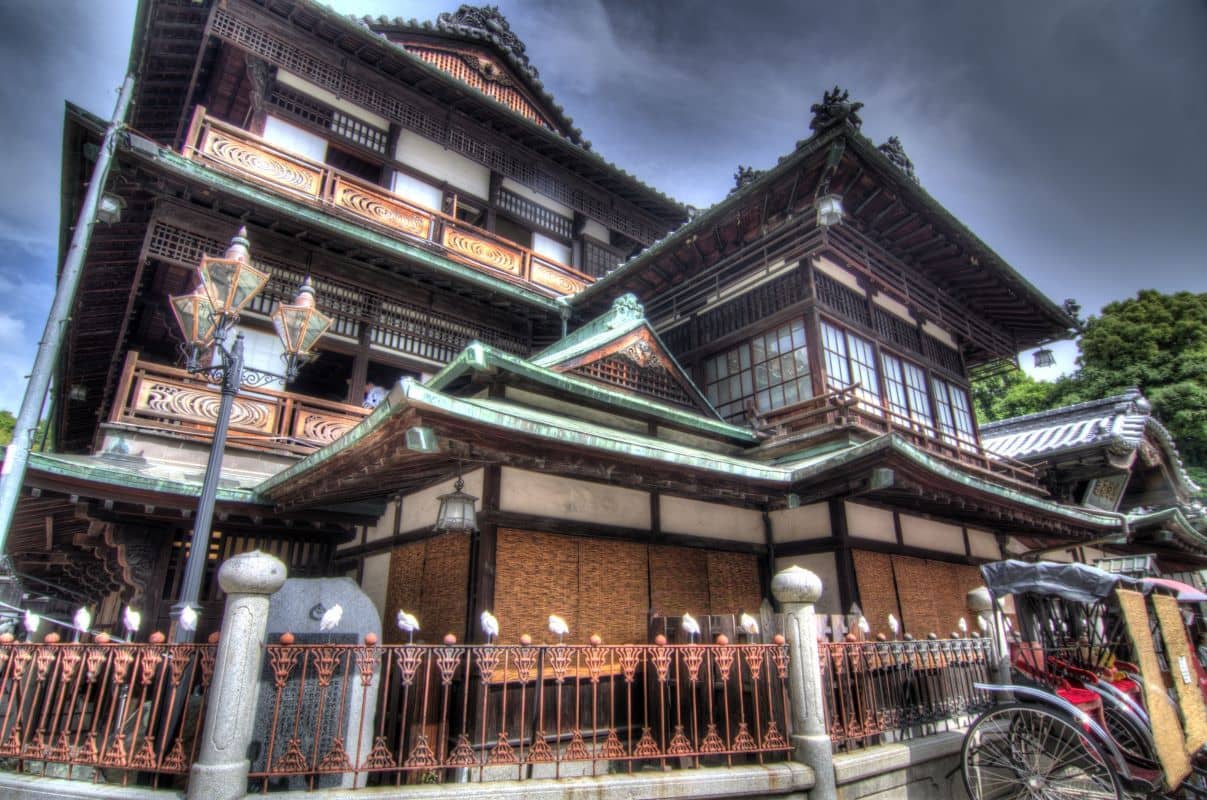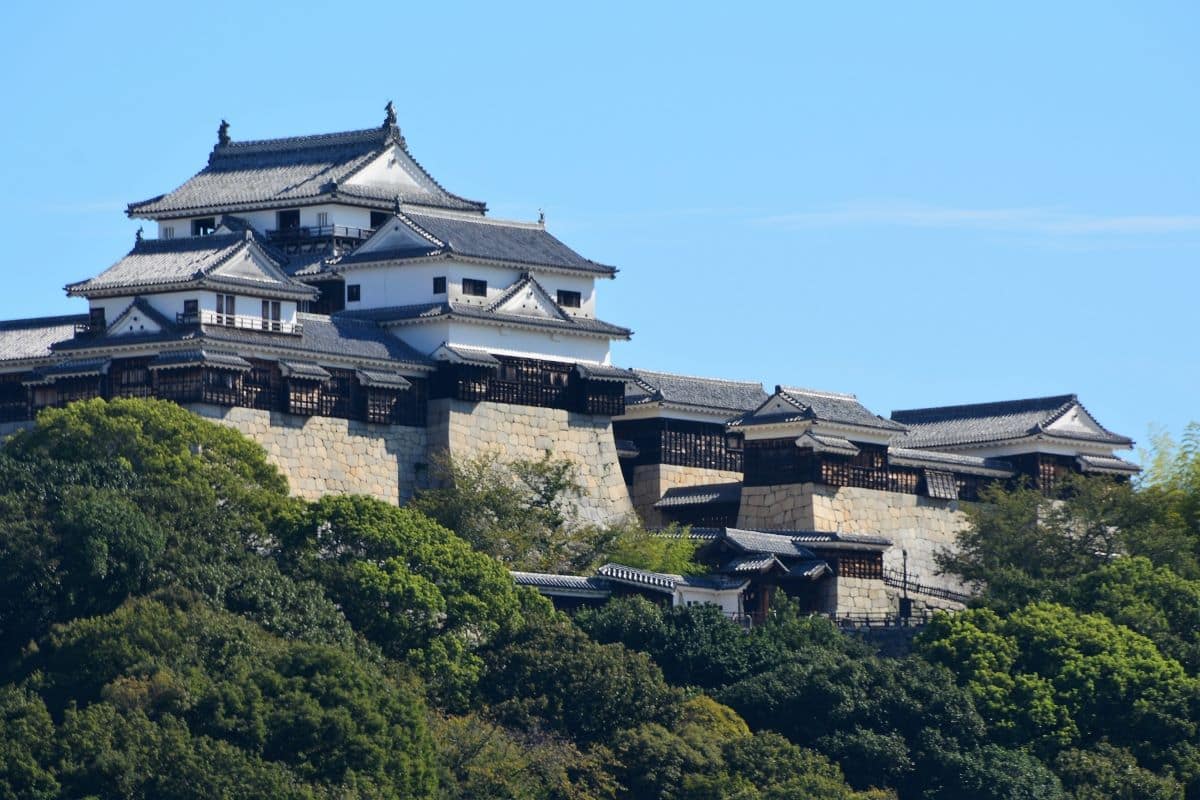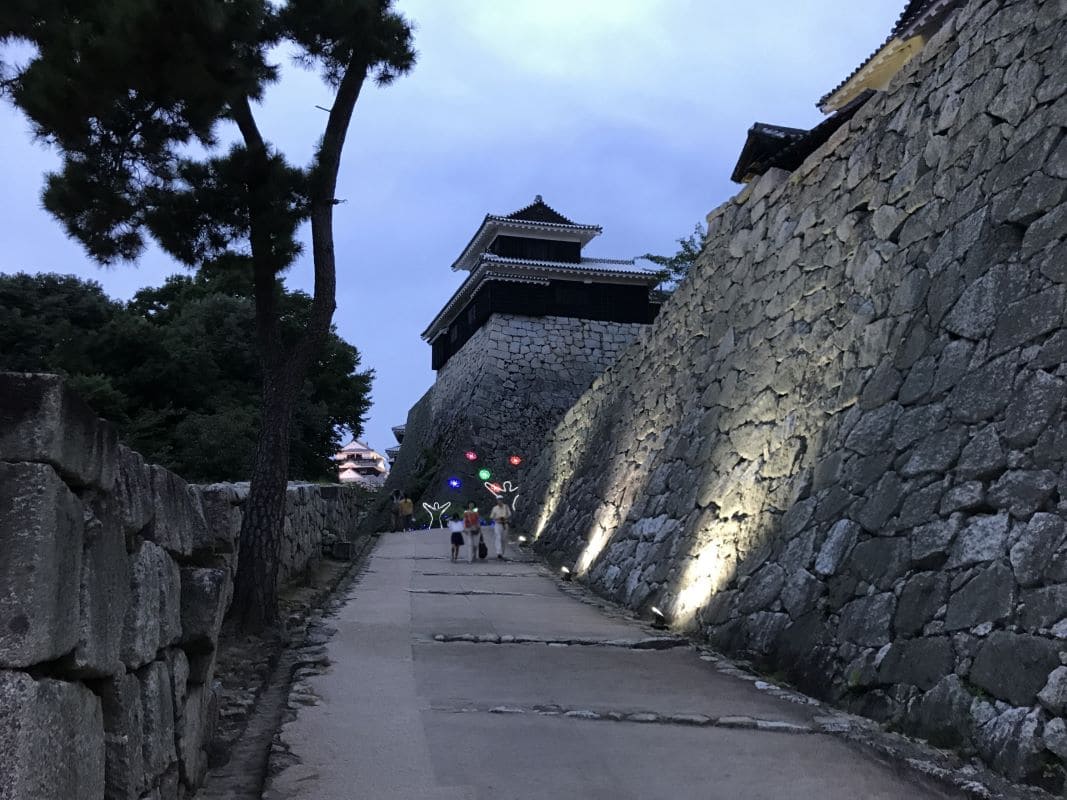Facing the Seto Inland Sea, Matsuyama is a fascinating city overflowing with history and literature, and hot springs.
Some of the best things to do in Matsuyama include visiting Matsuyama Castle, whose tower from the Edo period still stands, and Dogo Onsen, said to be the oldest and most famous hot spring in Japan.

If you like history, literature, and castles, this is a place worth visiting.
If you only want to see Matsuyama Town, which is compactly packed with attractions, you can visit the main tourist spots in a whole day.
After that, an overnight stay at Dogo Onsen is recommended. If you want to go a little further and visit the pottery studios of Tobe Pottery or Shimanami Kaido, you will need at least two nights and three days.
Matsuyama Castle

Only 12 castles still exist with their original castle towers from the Edo period and the imposing Matsuyama Castle is one of these 12 surviving castle towers.
It stands majestically on the 132-meter-high summit of Mt Katsuyama and visitors can either take a leisurely walk up the mountain path or use the ropeway or chairlift.

Matsuyama Castle’s main keep is designated as a national important cultural property and is the only one of the 12 existing keeps to have the Tokugawa family crest on its roof tiles.

The 360-degree panoramic view from the top floor of the castle tower is a must-see. The view of the Matsuyama Plain and the Seto Inland Sea is beautiful and changes with the seasons.
Dogo Onsen Honkan Main Building

The majestic Dogo Onsen Honkan is an iconic public bathhouse that is the symbol of Dogo and is the bathhouse of choice for the imperial family.
It is said to be the oldest hot spring facility in Japan and appears in the Chronicles of Japan and the Tale of Genji.

The enchanting bathhouse was the inspiration for the God’s bathhouse in the film Spirited Away and it was awarded the highest three stars in the Michelin Green Guide Japon in 2009.
The bathhouse has a unique atmosphere with its cylindrical hot water spout called a yugama and walls decorated with Tobe-yaki pottery tile paintings.

You can casually drop in just like a standard public bath, and the spa is well-loved by local residents. Soap and towels are available for rent at the adjacent store and you can even rent a yukata to walk around in.
Asuka-no-yu

There are three bathhouses in Dogo and one of them is Asukanoyu, which was newly built in 2017 and is just a 2-minute walk from the main building.
The Asuka-no-Yu is a bathhouse built in the Asuka period architectural style, with an open-air bath not found in the main building and a special bathroom that is a reproduction of the main building’s imperial private bathhouse.

There is also a 60-tatami-mat hall and five private lounge rooms with traditional crafts depicting legends related to Dogo, where visitors can relax after bathing.
You can also enjoy digital art expressions, such as the projection mapping images projected on the wall paintings in the bathrooms.
Dogo High Shopping Color Street

The picturesque shopping street leading from Dogo Station to the Dogo Honkan main building is nicknamed “Dogo High Color Street” for its Meiji-romantic atmosphere.
Lined with numerous souvenir stores, cafes, and restaurants, the street is always bustling with many yukata-wearing tourists, a sight that can only be seen in a hot spring resort town.

Eating and drinking along Haikara-dori is one of the best parts of sightseeing in Matsuyama.
Clock
Next to the entrance of the shopping arcade, there is a clock with the motif of the Dogo Onsen Honkan’s Furisagikaku and a footbath, which are not to be missed.
The clock usually moves every hour, so it is recommended to go see it around that time.
Matsuyama Attractions-Activities-Suggested Spots-Ishiteji Temple
Isaniwa Shrine

After climbing the 135 stone steps, you will meet the bright vermilion building of the vibrant Isaniwa Shrine whose gorgeous exterior is a sight to behold.

The shrine is one of the three major Hachiman-zukuri style shrines in Japan, along with Ishimizu Hachiman Shrine in Kyoto and Usa Shrine in Oita and is also a popular place to pray for good luck, protection, easy childbirth, and marriage.
Ishite-Ji Temple

The wonderfully strange Ishite-ji Temple is of the esoteric School of Shingon Buddhism built to worship Kobo Daishi. Located in the northeastern part of Matsuyama, not far from Dogo, it is the 51st temple of the 88 temples of the Shikoku Pilgramage.
The name of this temple comes means Stone Hand and comes from a legend that a stone appeared from a hand that was being held by the eldest son of the lord, Yukikata Kono, when he prayed at this temple.

Today, many of the wonderful buildings in Ishite-ji Temple are designated as national important cultural properties, and the impressive Niomon gate of the main hall is a national treasure.
Also on the temple grounds are the three-story pagoda, a large statue of Kobo Daishi, and the Treasure House, which houses many important cultural properties.

There’s also a hidden mantra cave that leads out to an extra rear temple ground that it somehow even more strange and enchanting than the main grounds.
Shiki Memorial Museum

This fascinating museum is a collection of materials on Shiki Masaoka, the famous haiku innovator.
The museum is decorated with many materials that allow visitors to lose track of time and immerse themselves in the history of Matsuyama, including the relationships between Shiki and the people around him, and the history of Matsuyama from the perspective of Shiki’s family.

The museum has nearly 60,000 items on display, as well as many exhibits using touch panels, making it a place where literature lovers can enjoy themselves.
Shiki Masaoka Shiki tried out a new style of literature (haiku and tanka) at the Nihon Shinbun newspaper, which he joined after dropping out of university, and he advocated sketch writing.

The museum is located right next to Dogo Park, a 5-minute walk from Dogo Onsen Station.
Ruins of Yuzuki Castle In Dogo Park

The fascinating Yuzuki Castle Ruins is the site of a castle built by the Kono clan, a medieval governor of Iyo Province, which flourished from the Nanbokucho Period to the Warring States Period.
An impressive 400 years of prosperous history came to an end when unifying warlord Hideyoshi Toyotomi attacked the castle and it collapsed.

The moat and earthen mounds have been preserved as they were in those days, and the samurai residences and earthen walls have been reconstructed and reproduced to give visitors a powerful experience of the castle ruins.

From the ruins of the castle, you can almost feel what it would have been like back in the time of Yuzuki Castle.

Since it is located right next to Dogo Park, you can also stroll around the relaxing park which is a famous place for cherry blossom viewing in spring.
Botchan Train

The iconic Botchan Train is modeled after the steam locomotives that once ran for 67 years through the streets of Matuyama.
The name Botchan Train came about because a character in Soseki Natsume’s classic novel Botchan used the former steam locomotive and described it in his book.

The train can be boarded from the Dogo Onsen, Okaido, Matsuyama-shi Station, JR Matsuyama Station, and Furumachi Station stops.
Dogo Onsen Station

Dogo Onsen Station, the nearest station to Dogo Onsen, is a restored former station building built in the Meiji era.
As the terminal station for the Botchan train, visitors can see the locomotive turning around.

There’s also a Starbucks inside where you can enter and enjoy the simple Meiji style of the wooden interior.
Bansuisou

This french-style building with the aroma of Taisho period Romanticism was built as the villa of Count Sadamo Hisamatsu, a descendant of the former feudal lord of Matsuyama.
The stylish interior of the villa evokes the atmosphere of the days when it was a social gathering place for distinguished persons and you can enter and see the gorgeous hall and beautiful stained glass windows.
Clouds over the Hill Museum

The beautifully designed Clouds over the Hill museum commemorates the acclaimed novel Kumo-no-Saka-no-Ue or Clouds over the Hill which depicts the growth of Meiji Japan as a modern nation through the lives of Matsuyama-born Akiyama brothers and the father or modern Haiku Shiki Masaoka.
In addition to exhibiting the footsteps of the three protagonists in the novel and other exhibits related to the Meiji era, the museum also hosts a variety of activities related to urban development, providing a place for visitors to feel and think about the passage of time.
Kururin Ferris Wheel

The Giant Ferris Wheel named Kururin is located on the roof of the Iyotetsu Takashimaya Department Store, the station building of Iyotetsu Matsuyama-shi Station.
From the Giant Ferris Wheel Kururin, visitors can enjoy a 15-minute spin in a gondola and enjoy a panoramic view of central Matsuyama, the Castle on the top of Katsuyama Mountain, and the islands of the Seto Inland Sea in the distance.
Up to three accompanying persons can ride for free during your birthday month (proof required), and one free ride is available with the purchase of an unlimited ride ticket for Iyotetsu city trains or a ticket for the Botchan train.
Okaido Shopping Street

This 483-meter-long shopping street stretches from north to south and leads all the way to the ropeway station for the castle.
It is a convenient area with a variety of facilities ranging from department stores, famous chain stores, restaurants, convenience stores, pharmacies, and business hotels.

In the side streets just off the main Okaido you can find some great hidden gems such as small cafes and restaurants.
The area is connected to the ropeway street on the north side and Ginten-gai, another undercover shopping street on the south side.
Hyota Ramen

Hyota is the original store of the Matsuyama ramen known as Hyoukei. The soup is made with chicken stock and pork skin as its base, and sweet soy sauce.
Once you try it, you will become addicted to it, and there is no end to the number of fans who come from far and wide, both locals and visitors alike.
Oden, which is stewed in the same broth as the ramen, is also available, with the flavorful tofu and pork tendon being highly recommended.
Where to stay in Matsuyama
The historic Dogo Onsen spa resort area is full of attractive lodging facilities, from long-established ryokan to hotels offering unique services. Here are a couple of the best places to stay in Dogo Onsen.
Funaya Dogo Onsen
The unique Funya is the oldest ryokan in Dogo and has been in business for more than 390 years. Soseki Natsume, the author Botchan, and successive Emperors and Empresses have often stayed at this prestigious onsen inn.
Dogokan

The stylish Dogokan is a luxury ryokan designed by world-renowned architect Kisho Kurokawa. The ryokan has many attractive rooms, including rooms on the top eight floors overlooking the city and rooms with open-air baths that draw hot spring water from Dogo Hot Springs.

The cuisine is also attractive, featuring seafood from the Seto Inland Sea and mountain delicacies nurtured in the nature of Ishizuchi.
What To Eat In Matsuyama?

Matsuyama and Ehime Prefecture is known as the Mikan Kingdom because of its extensive cultivation of mandarin oranges and the variety of citrus fruits available.
For this reason, there are many sweets made from mandarin oranges, which you should try, and because the area faces the bountiful Seto Inland Sea, it is also a good place to eat fresh fish and shellfish.
Tai-Meshi, a dish of sea bream and rice is especially famous and delicious. Matsuyama-zushi is a type of chirashizushi unique to Matsuyama, and its vinegared rice is made with fish stock.

And don’t forget to try the good old Botchan Dango (dumplings) and Matsuyama tart, which are both of Botchan fame.
More Things To Do In Matsuyama
Here’s even more ideas:
- Iyonada Monogatari Sightseeing Train
- Take a ferry trip to a nearby island
- Head to Northern Ehime Prefecture and visit the towel museum in Imabari



